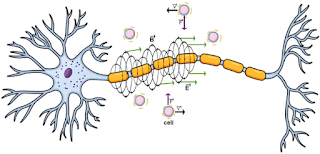Lately I've been captivated by an idea: electromagnetic theories of consciousness, which hypothesise that conscious experiences are identical with certain electromagnetic (EM) patterns generated by the brain (Pockett, 2012). The central claim of these theories is that spatiotemporally integrated information in an electromagnetic field feels like something.
Dr Mostyn W. Jones, a philosopher of mind at University of Manchester, provides a good summary and comparison of EM theories of consciousness (2013), which come in a range of flavors: computationalist, reductionist, dualist, realist, interactionist, epiphenomenalist, globalist, or localist.
What's the physical basis?
Each neuron when firing generates an electric dipole field, and the overlap of these fields from the firing of many neurons across the brain produces an ever-changing and unified brain-wide electromagnetic field of extraordinary complexity. That much is known. EM field theories of consciousness take the leap of identifying this EM field with the contents of consciousness.
Electromagnetism is singled out from the other fundamental forces: gravity is too simple in field structure, and the nuclear forces are too short-range to integrate a large amount of complex information.
What makes the theories appealing?
The most appealing feature of locating consciousness in the brain's electromagnetic field is that it solves the binding problem: the field unifies the disparate information about the visual field, sounds, smells, thoughts, bodily sensations and so forth. Without binding, one has 86 billion individual neurons firing, various brain regions processing different aspects of sensory input, and no way to "put it all together" into a single unified experience of consciousness.
It makes sense that consciousness derives from the electrical activity in the brain, as that's what changes sub-second timescales. The chemical communications between neurons and the physical wiring up of synapses are slower processes, participating in learning rather than consciousness.
Who is working on it?
Dr Susan Pockett, a neurophysiologist at the University of Auckland has brought the most rigor to EM field theories of consciousness, drawing extensively on EEG and MEG studies showing correlations between sensory qualia and field patterns (Jones, 2013). It's a difficult study this intersection of neurophysiology, physics, and metaphysics.
An enthusiastic proponent of "cemi" or "conscious electromagnetic information" is Johnjoe Mcfadden, a professor of molecular genetics at University of Surrey and author of Life on the Edge. Mcfadden has eagerly proposed roles for quantum coherence, tunneling and entanglement in various aspects of biology, but seems to have a poor grasp of the physics. His writings on (2020) writing are inspirational, but not rigorous.
EM theories of consciousness are not popular. The main theories are information-based theories such as higher-order theory, global workspaces theories, integrated information theory, and predictive processing theory (Seth 2022). These theories all focus on the information processing done by the brain. Pockett is really the only researcher putting their name behind EM fields in 2022.
The prevailing view seems to be that the EM fields generated by neurons are as relevant to understanding how brains generate consciousness as exhaust gases are to understanding how cars propel themselves.
What would EM field consciousness imply for AI?
EM field theories of consciousness align with Searle's Chinese Room thought experiment: that sequentially integrating information one step at a time in a computer will not produce a conscious experience. Even a whole-brain simulation would produce a philosophical zombie that does not achieve consciousness, and may not even behave like the original. And in general, a Von Neumann architecture machine, whatever software it is running, would not produce a field that integrates all the information at once. In contrast, prevailing theories of consciousness suggest that the right kind of information processing will yield consciousness, even in software.
Dr Pockett speculates that should be possible to build hardware that generates a conscious EM field, talking about a box that solely experiences "hearing middle C", and eventually building conscious machines.
Mind uploading still seems far from feasible: from picking apart a brain down to a molecular level of detail, to building equivalent (but more robust) hardware that produces the same EM field patterns, it all seems far beyond the horizon of technology I can imagine.
Is consciousness an epiphenomenon?
In a state of nondual mindful awareness there is only an open experience of the contents of consciousness, without a sense of a "self" or "observer" or "driver" behind the eyes. When the sense of "observer self" reasserts, it then does so as another thought or sensation in the open field of conscious awareness. The meditation app Waking Up by Sam Harris teaches one how to achieve a nondual state by practising the art of "looking for the self, and failing to find it", and compares achieving nondual mindfulness to flipping the state of a visual illusion like a Necker cube, or seeing the reflection in a window instead of looking through it. Something about this trick brings to my mind the Hitchhiker's Guide to the Galaxy, on the art of learning to fly by accidentally missing the ground.
I think nondual mindfulness aligns well with EM theories of consciousness, by identifying the contents of consciousness with contents of the EM field: a bundle of qualia without a privileged "observer self" watching the show.
Conclusion
EM field theories of consciousness appeal to me because the binding problem posed an impenetrable mystery to me for many years, while an electromagnetic field detailed enough to incorporate all the information seems intuitively like an answer.
That said, the idea still leaves mysteries such as why should a specific spatiotemporal pattern of EM field feel like something? No good reason comes to mind. And such a wide variety of qualia too: colors, sounds, smells, touch, proprioception, emotions, and whatever it is that bats experience through echolocation, all integrated in a coherent manner.
I am hopeful that the field of consciousness studies will begin to unravel the mysteries of consciousness. I do love a good mystery, especially the part of figuring it out.

Comments
Post a Comment